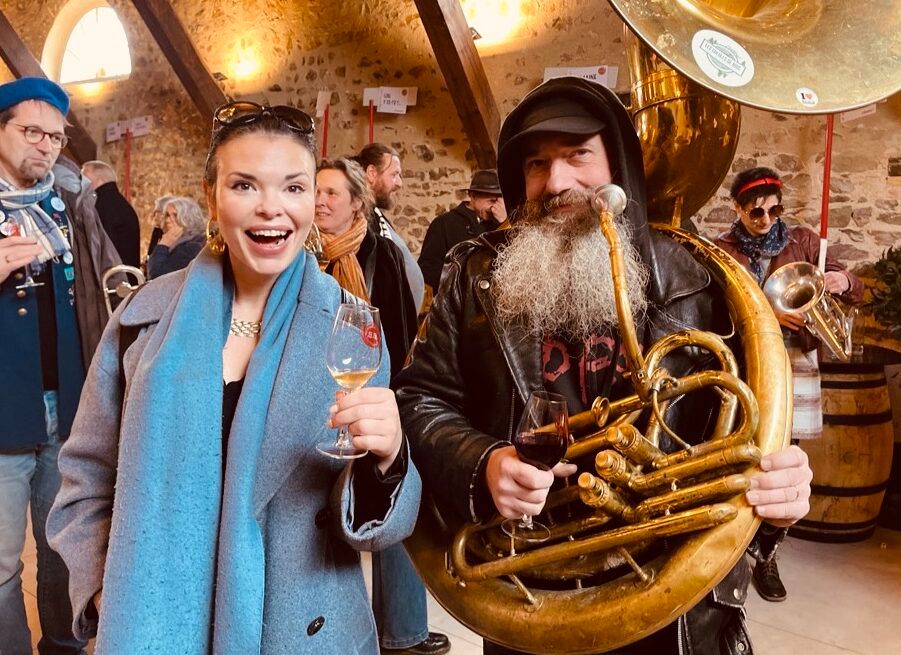What happens when 3 immodest femmes de la vigne find themselves in the wilds of Beaujolais, steeped in bacchanalian festivities and youthful vignerons? Lisse Garnett, Kate Hawkings and Libby Brodie found out.
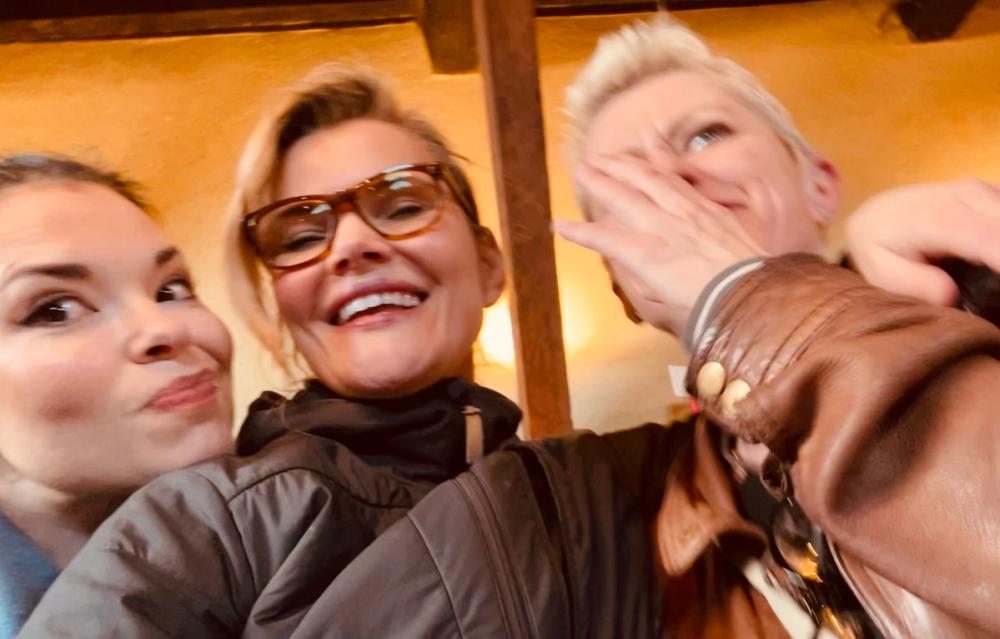
Sounding like a bad cop show: Brodie, Garnett & Hawkins
Whilst many of you roamed the well-trodden paths of Découvertes en Vallée du Rhône, we three wine radicals discovered something wonderful in the birthplace of natural wine, by hitting the offbeat tastings and magnum parties of Bien Boire en Beaujolais, which was held at the same time and hosted by Beaujol’Art, Biojolab and Beaujol’Wines (I think). It was hard to tell. Every gathering had the casual vibe of an impromptu, raucous yet vinously sophisticated party.
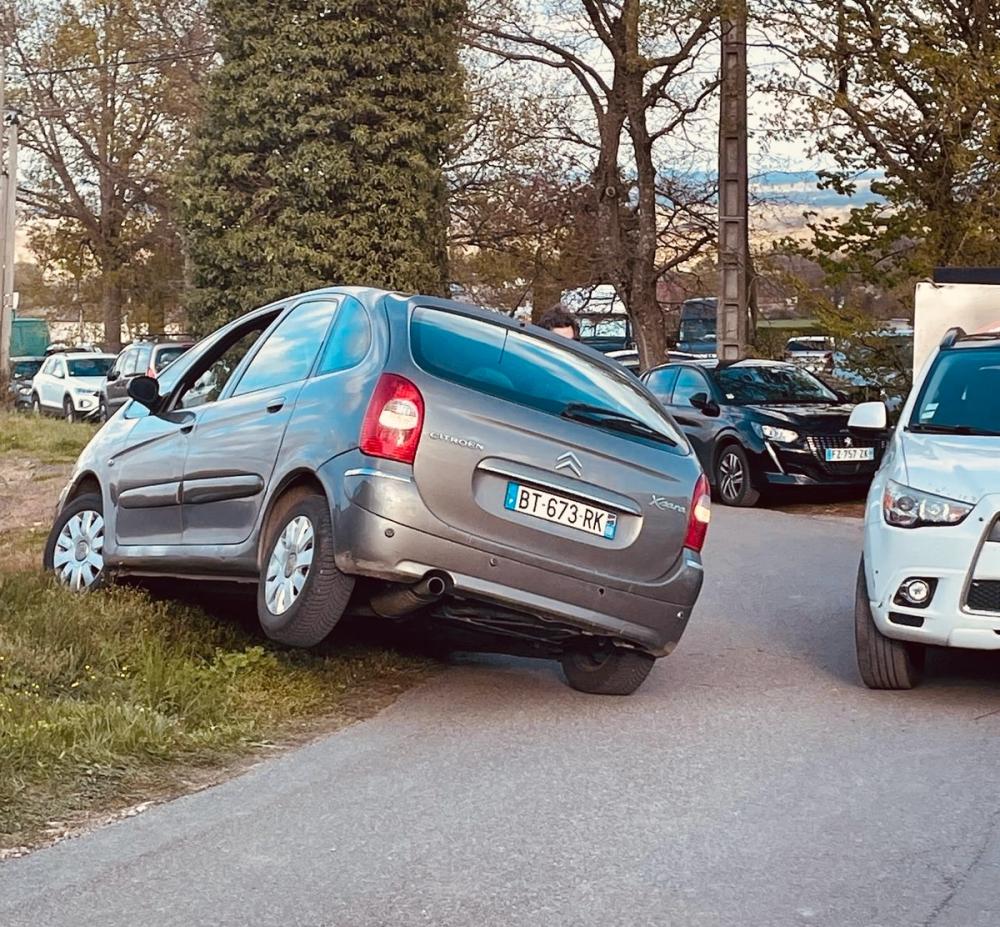
Parking Beaujolais style
At Belleville-en-Boujolais we were greeted by an upended Citroën in a ditch. There were also huge cauldrons of steaming molluscs steeped in chorizo, multiple magnums and a heart stopping view. The 12-piece brass band playing Radiohead was unexpected as were the twirling, dancing Dutch and well, there are some things that happen in Beaujolais that stay in Beaujolais.
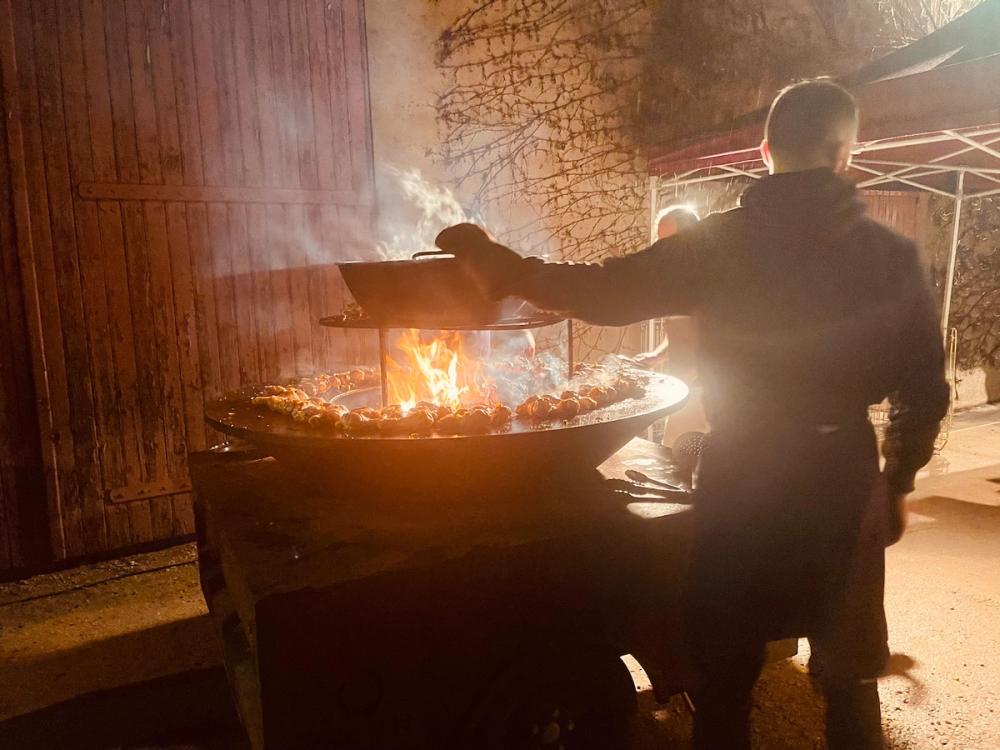
Meat and mollusc fest
Nobody communes like the French. They enveloped us into their throng without explanation nor second glance. No one would have dreamt of offering us anything so gauche as product information. We were seamlessly absorbed into enchanting company and seduced by youthful zealots of the vine. A group of wine-crazed, maverick, dancing Dutch importers were the only other foreign interlopers we met. Thus, we buzzed like pioneers, like smug 80s ravers who’d blagged their way backstage to hang with the band at the mightiest of secret gigs.
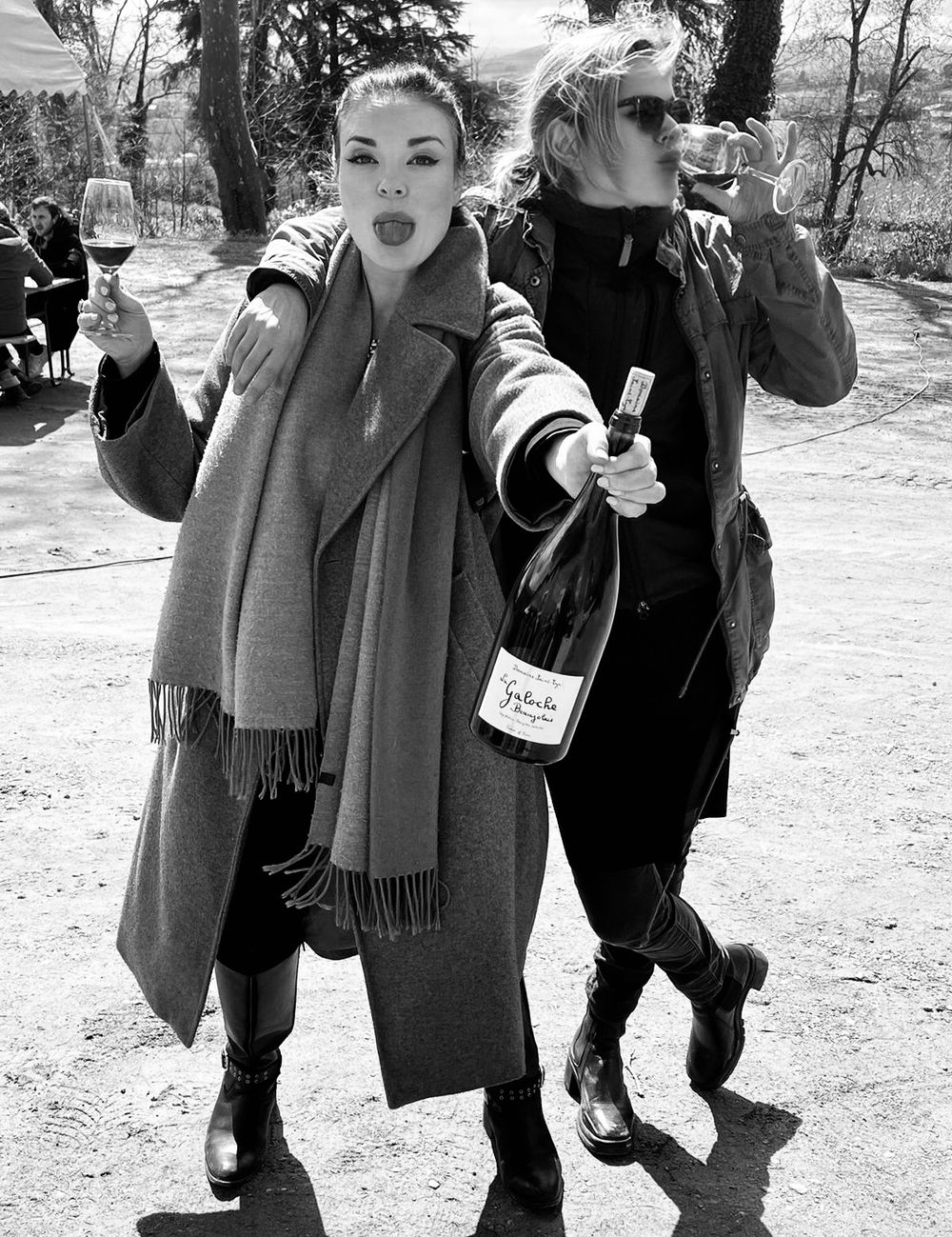
Slightly messy: Brodie and Garnett
Nouveau and natural
There are many sides to Beaujolais, but Beaujolais Nouveau is the name the man on the street knows. It used to be sexy, too sexy, it was everywhere. Over egged and marketed to within an inch of its credibility, it shrank back into obscurity and became a bit of a joke, not least in its homeland. Beaujolais producers have celebrated the harvest by sharing young wine, or vin de primeur, that is made and sold the same year for over a hundred years. Released on the 3rd Thursday of November; fresh, fruity and full of youthful sapid energy, it should be low priced and is ideally supped in Paris with steak frites.
In the 70s Bojo Noveau hit London, thanks to a campaign that was inadvertently lit by the London papers. According to Oz Clarke it was the Sunday Times journalist Allan Hall who kicked things off. He promised to give the first person to walk in his office on the 15th November 1974 with a bottle of fresh Beaujolais a bottle of good Champagne. He started a race. The lunatic British wino fringe took to the roads in all manner of rangy vehicles – traversing the French countryside in an attempt to get to London avec le Beaujolais Nouveau, only to be pipped at the post by some unsportsmanlike individual who made use of a private jet. Beaujolais Nouveau made household names of growers like Georges Duboeuf.
Let’s not forget Beaujolais is also the birthplace of natural wine. It began when Marcel Lapierre, Jean Foillard, Charly Thevenet, and Guy Breton decided to make wine like their grandfathers. They saw the results of industrial post-war farming and they wanted out. The wines they made spawned a movement that resonated across the world. Today the party they started in Beaujolais is propagated by conscientious younger growers who are keen to protect the environment and express the region’s heritage as well as complex terroir.
Getting Beaujolais on the map
Beaujolais overlaps the Mâconnais in the Southern part of Burgundy but much of its territory lies further South in the Rhône Department and is not far from Lyon, France’s gastronomic mecca. Though primarily a region known for red wine made from the Gamay grape (98% of plantings are Gamay), white and rosé wines are also being produced from small plantings of Chardonnay and Pinot Noir. From 2009 to 2018 soils were comprehensively mapped thus allowing growers to create plot-by-plot cuvées. They can also now use the ‘Unesco Global Geopath’ label in recognition of Beaujolais’ outstanding geology, some of the richest and most complex in France. The climate too is complex and subject to three main climactic influences; continental currents, oceanic air movements and Mediterranean winds.
Over half the world’s Gamay is located in the Beaujolais AOP. Planted here since the 17th century, predominantly on granite, these thin, delicate, purple/black-skinned grapes are fairly good at adapting to soil but do require meticulous care and attention. A natural cross between Pinot Noir and Gouais Blanc, Gamay can produce age-worthy wines of great elegance and finesse as well as supple, fruit-forward, lower alcohol bottles, showing pretty strawberry and raspberry notes and nuanced, floral, peppery aromatics.
Carbonic maceration and semi-carbonic maceration are used. Semi-carbonic is more common. Fruity and highly floral, wines made this way show softer tannins, and in younger wines, such as Beaujolais Nouveau, yeast notes are suppressed. Carbonic maceration has been adopted by growers throughout the world keen to convey fruity flavours and freshness, but it all started in Beaujolais.
Beaujolais is a region that offers much that is memorable, complex and nuanced in terms of range and style. The distillation of the Beaujolais concept allows for over-simplification of what is essentially a broad canvas. Beaujolais perfectly illustrates the wonders a varied terroir might convey on a single variety. Beaujolais Crus might not even use the word Beaujolais on their labels, so all need to be memorised and explored to be understood. This exciting and diverse region is fascinating, impossible to pigeonhole and incredibly it suits all budgets. Rare words to hear in association with Burgundy.
More and more drinkers view these wines as an alternative to red Burgundy – now so costly you need to sell your front teeth to buy it. St-Amour, Juliénas, Moulin-a-Vent, Chénas, Fleurie, Chiroubles, Morgon, Régnié, Brouilly and Côte de Brouilly are the ten Beaujolais Crus. While the southern region of Beaujolais is flatter and clay-based, these northern crus offer fruit grown on the monts de Beaujolais – granite hills that deliver richer, more complex and more full-bodied wines.
Styles offer broad and varied personalities, and some are age-worthy. Seductive and enticing, they can be anything from lithe and ephemeral Chiroubles to dark and even tannic such as those from Moulin-a-Vent. I have included information on individual crus in the tasting notes below.
Interestingly when the Grand cru appellation in the Cote d’Or relaxed their regulations on maximum yields, Beaujolais vignerons tightened theirs. This is a region that is extremely keen to prove itself worthy of note.
And so what about the wines?

A lot of what we tried is simply not in the UK, here are a mighty few that are, I’ve tried to include the natty, the natural and the more traditionally poncey too. I cannot recommend enough going out there to party and sup yourself, as for much of the time I was having too much fun to write notes.
Château Grange Cochard, Morgon, Les Charmes, 2020, 13.5%
Wines from Morgon are said to be fuller flavoured and grown on weathered schist on the south-facing slopes of Mont du Py. Dense and delicious, this wine certainly delivered. Made by Brits from old vine fruit dating back 40 to 100 years, grown on the aforementioned pink granite, semi-carbonic, half full bunch, unfined, matured in oak, conversion to organic is underway. Intense perfumed notes balance a sensual muscular structure. Fruit is concentrated; strawberry, cherry and raspberry – tempered by earthy, gently gripping tannins and a hint of coffee. The wine is fresh and sappy yet layered and rich with interest. Super elegant yet mighty. Insanely well priced, extremely well done by Woodwinters. RRP £19.95, Woodwinters.
Julien Sunier, Fleurie 2021, 11.5%
Sunier makes incredible terroir-expressive wines and is a bit of a rockstar wine god now. This wine is again made with old vines, using carbonic maceration, aged in oak. It shows that light, otherworldly elegance that lifts certain wines toward the divine. A delicate hint of rose petal lends a floral note to this sapid red fruit-laden sup. Fresh raspberry, pomegranate and cranberry enliven a silken texture, enriched with moreish, superfine tannins. So sensual. RRP £31.00, Roberson Wine.
Maison Louis Jadot, Château des Jacques, Clos de Rochegrès, Moulin-à-Vent 2021, 13.5%
Perhaps seen as fancier than the other crus and often the call people make as an alternative to Burgundy. The soil is pink granite, just like Fleurie. Gorgeous, round and even buxom, Moulin wines usually deliver in terms of grace and value. Jadot bought this estate between Fleurie and Chénas in 1996. This is from a clos made up of old vines, on ancient granite and is vinified in closed vats, pumped over and aged in new oak for 12 months. The wine is fresh and redolent with cherry, almond, strawberry, raspberry coulis and a hint of Bakewell Tart. Succulent fruit is balanced by moreish, burnt, bitter biscuit. Spiced, elegant, densely delicious, the tannins are fine-grained, moreish and supple. J’adore. RRP £26.98, Hatch Mansfield.
Famille Guerin Moulin-à-Vent, Les Thorins 2020, 14%
Unfined, unfiltered, native yeast, semi-carbonic, concrete and old oak. A natural wine made from grapes in conversion to organic. Sour, sapid, crunchy cherry, violet, plum, blackberries, the silken texture culminates in a tannic finish with a delicate hint of rose petal and exotic incense. It is fresh, bloody, bitter, spiced and muscular, iron-tinged with grainy tannins and a lengthy finish. RRP, £29.50, Wayward Wines.
Cuvée Mélanie, Vins Mélanie et Daniel Boulard, Côte de Brouilly, 2021, 13%
Brouilly is the largest cru (containing Côte de Brouilly) and is situated around Mont Brouilly – often mouth-wateringly fresh and fruity. This cru permits Chardonnay, Aligoté and Melon de Bourgogne as well as Gamay. Cuvée Melanie comes from Boulard who is famous for his Morgon. This wine is made from old vines, its nose is gorgeously perfumed, fragrant with fruit, spice and a savoury, cola-tinged depth. On the palate it is dry, superbly silky, savoury, lifted by lavender; the fruit is reserved, the tannins intensely moreish and the finish, stony. Delicious. RRP £20.00, Vine Trail.
Fleurie La Madone, Domaine Chamonard, 2019, 13.5%
Jean-Claude Chanudet aka Le Chat and the late Marcel Lapierre were childhood friends who travelled the world working together. The two friends set up Château Cambon. Chanudet took over Domaine Joseph Chamonard when Lapierre died. They were part of the group who spoke out in favour of natural wine, though Chanudet is now vehemently against the dogma of the movement that he derides as a new religion.
So prettily named and also apt, wines from Fleurie are often floral, fragrant and aromatic, a pleasure to sup. Jean-Claude’s Fleurie La Madone, made from his wife’s vines, comes from the most famous and oldest plot in Fleurie, grown biodynamically on decomposed pink granite. Violet, cola and high church incense meet intense minerality. The tannins are elegant and supple – it’s fruity too, of course, but the elegant perfume and earthy minerality move the dark fruit in a textured, savoury direction. I really love this wine. RRP £27.00, Vine Trail.
Droit de Véto Fleurie, Domaine J.Chamonard 2021, 12.5%
Succulent and gentle, incense-noted, earthy and deep, yet mineral-rich. All manner of soft red berries enliven this silky, perfumed, light yet characterful, delicately salted sup. RRP £22.00 (ish), Vine Trail.

Thomas Rivier, Cuvée Tomix, 2021, 12.5%
We tried and loved all of Rivier’s wines, they are wildly new and fresh and yet still have the hallmarks of granite and tradition, I would encourage you to try them all and the labels are fantastic, Thomas designs them himself. Vinous savant, Claire Thevenot MS is his importer in the UK. Organic and made from old vines, (as were a huge proportion of the wines we tasted) Tomix is partially aged in concrete, semi-carbonic and naturally fermented. Succulent with dark fruits, blackberry and blackcurrant, it has a tender, moreish, savoury/soy and liquorice note. It’s delicately floral too with violet and spring blossom. An intense, energetic, almost febrile wine. Absolutely wonderful with sweet, caramelised, bloody lamb. RRP £28.00, Vins Clairs.
Famille Guerin Moulin a Vent, Les Thorins 2020, 14%
Unfined, unfiltered, native yeast, a natural wine made from grapes in conversion to organic. Sour cherry and plum; a silken texture culminating in deliciously dry tannins. It is fresh, bloody, iron-tinged with a long, grainy, textured finish. RRP, £29.50, Wayward Wines, Les Caves de Pyrene.
Domaine Gilles Paris, Chiroubles, Terroir 2019, 13%
An average altitude of 1000 feet in Chiroubles produces light, refreshing, delicate, floral, fragrant wines. Biodynamically made, whole bunches, aged in old wood. Black and sapid, crunchy red cherry, laced with black pepper and deep, dark, savoury high church incense. Dry, textural tannins enrich a long, sour, fresh cherry finish. Extremely moreish and fantastic with fat. RRP £24.50, Theatre of Wine, Les Caves de Pyrene.
Domaine Thillardon, Vibrations, Chénas 2021, 11.5%
Chénas is the teeniest of the crus. Granite soils dominate. This was once a region known for oak hence the name. Wines are spicy, sapid, often age-worthy and fragrant. The smell of roses is a well-used descriptor. Semi-carbonic, made from biodynamically farmed old vines. Perfectly petillant; fresh, alive and zippy; this radiates life with a hint of farmyard, earth and sage. Sour, wild, sapid strawberry, rhubarb, orange peel, white pepper; super dry and chalky with tannin. Deliciously long. RRP £33.00 Natty Boy, Les Caves de Pyrene.
Domaine Joseph Chamonard, La Cuvée du Chat, 2021, 12%
Founded by Marie and the late Marcel Lapierre and Jean-Claude Chanudet in 1995. 13 hectares of Gamay, mainly in Morgon plus a small parcel of vines in La Côte du Py. The vines average 60 years. Organically farmed and low intervention. Soft, sour morello cherry and fresh orange peel, saline-tipped sour fruits, crunchy cranberry; mouth-watering acidity, all gorgeously countered by earthy, dry tannins and a hint of mint. The texture is silky and delicately laced with fragrant, subtle notes of wild rose. RRP £20.88, Sip Wines, Les Caves de Pyrene.
M&C Lapierre à Ville Morgon 2021, 12.5%
Fruit came from old vines; the wine was aged for ten months in oak. No sulphur was used during élevage, only bottling. Succulent raspberry, a delicate hint of wet woodsmoke, dark damson and spice. Super fresh, sapid, crunchy and tart with cranberry and sour cherry, pomegranate and raspberry. Dry, delicate, delicious and beautifully pure. RRP £32.00, Wayward Wines, Vine Trail.
Domaine de la Bonne Tonne, Morgon ‘Grand Cras’ 2020, 14%
Biodynamic, whole cluster, semi-carbonic, aged for around eight to nine months in old foudres. Minimal sulphur. Cherry, black pepper, raspberry, cranberry, blackberry, plum and incense. Fresh and succulent, enticingly wild and sour with a gorgeous violet note. Delicious after decanting, natty before but perhaps only to me. RRP £27.80. The Wine Society/Vine Trail.
Château de Grand Pré, Fleurie 2021, 13%,
Organic and made with the absolute minimum of intervention. Vibrates with intense orange pith, deep plum, sour cherry, pomegranate, cranberry and black pepper. Super alive but not sweet with fruit, more delicate with a savoury liquorice, flower-tinged violet note. Beguiling. RRP £20.95. Steep Hill Wines/Les Caves de Pyrene.

Nouvelle cuisine Bojo style
